Econ 101 Series #2: Understanding Inflation
Let’s say the price of your favorite candy bar is suddenly higher and you were forced to fork over $2.75 instead of the usual $2.50. Interestingly enough, none of your other groceries went up in price. Later in the day you read online about how the price of cocoa beans have spiked because of an unusually colder growing season in South America. The article predicts that prices will normalize sometime in the next three to four months, as additional cocoa crops are harvested and add to the overall supply. Accordingly, the price of your candy bar goes back down and all is well. That price increase you experienced was inflation, right?
Not so fast. Recall that in our imaginary scenario the price of cocoa beans increases for a limited period of time, but then decreases back to ‘normal’. Higher-priced candy bars for approximately four months, without corresponding price increases in many other food items is not an example of inflation. In other words, inflation doesn’t happen every time there is a price increase. Confused?
Consider a different scenario, this time using the automotive industry as an example. Let’s say that Ford raises the prices on all their new vehicles by 2%, due to increased labor and material costs. GMC, which is equally impacted by these same factors, raises the prices on all their vehicles. Toyota and Honda see this happening and raise their respective prices accordingly. Seemingly overnight the market for new cars suddenly became more expensive. Two percent more expensive, to be exact. But there is more bad news. Other manufacturers producing consumer goods are now realizing the same increased costs of production, and in turn…you guessed it…raise their prices. Unfortunately, it takes the market almost two years to stabilize.
Citizens across the country are now paying more for similar household items, like groceries, vehicles, and cell phones and continue to do so for several months. This, friends, is inflation. The Federal Reserve, think of them as the National Bank, offers the following definition of inflation: “Ongoing increases in the general price level for goods and services in an economy over time” (clevelandfed.org). Simply put, inflation is when prices arise across many goods for an extended period of time. In other words, the majority of things become more expensive, rather than just a few items.

Image by brgfx on Freepik
How Is Inflation Measured?
So how do we know if only a few consumer goods have become more expensive, or the increase is more widespread and thus true inflation? Good question! The answer is economists use various tools to evaluate price increases and one of the most common of these is the Consumer Price Index, or CPI. The CPI is a “basket” of common goods and services that has been determined to be typical of what most citizens purchase on a bimonthly basis and quarterly basis. In order to determine what specific items to include, approximately 21,000 consumers regularly record their purchases and report these to the federal government. In addition, the CPI is periodically updated to include factors such as changes in consumer buying habits or shifts in population (U.S. Bureau of Labor Statistics).
Wrap-Up
Have questions or want to discuss further? Stay tuned for our next installement of Econ 101 when we will talk about Interest Rates. In the meantime, contact the Cattaraugus County Department of Economic Development, Planning and Tourism (EDPT) to find out ways we can support your business in Cattaraugus County. Our Development Specialist can be reached by phone at 716-938-2311 or via email at tesowers [at] cattco.org.
